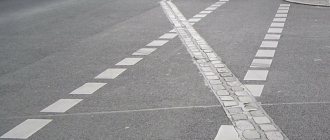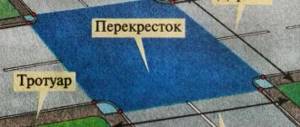In other words, you should imagine this section of the road as an “ideal” road, on which all the “extra” components listed above are absent. After this, you must draw a conditional longitudinal line in the middle of such a road, and consider the half of it located to your left as the desired “oncoming traffic”, entering which is punishable to the fullest extent of the traffic rules. Note: It is very important not to make the mistake of increasing your side of the roadway. It is fraught with serious consequences, as it can cause a collision with an oncoming vehicle when overtaking, turning left or making a U-turn. This division of the roadway in half is valid for any width, including a 4-5 meter driveway.
How many lanes are there on a particular road? fines for driving outside the lanes.
- Setting the number of lanes if there are markings for all lanes
- Establishing the number of lanes when there are only markings separating traffic flows in oncoming directions.
- How many lanes are there on a roadway without markings?
- Sequence for establishing the number of lanes.
- Sanctions and fines for driving outside the lanes.
This publication will focus on determining the number of lanes on a particular road. Even if, initially, it seems that finding the number of lanes on a freeway is quite easy, in fact this is to some extent incorrect. There are plenty of circumstances in which you need to think carefully to find the right solution.
Clause 9.1 - determining the number of traffic lanes on the roadway
If there are no markings and (or) the indicated signs, then the number of lanes for trackless vehicles is determined by the drivers themselves, taking into account:
- width of the roadway;
- dimensions of vehicles;
- safety intervals between cars.
When determining traffic lanes on a road with missing road markings (or the signs listed in paragraph 9.1), you must first determine the direction of oncoming traffic. To do this, you need to conditionally divide the roadway in half.
In the presence of:
- acceleration or deceleration lanes,
- drive-in pockets intended for stopping route vehicles,
- additional lanes for ascent
Definition by signs
The number of traffic lanes is determined by road signs 5.15.1, 5.15.2, 5.15.7, 5.15.8.
Determining the number of lanes with signs
5.15.1, 5.15.2, 5.15.7, 5.15.8 are exhaustive signs; other signs do not have such a purpose.
These signs do not specify the number of lanes
For example, sign 5.11.1 “Road with a lane for route vehicles” does not define two lanes, but designates one oncoming lane for MTS.
Driving towards traffic in the absence of markings - is this a violation?
If this situation is considered in the presence of a traffic police inspector, then with a high degree of probability it can be argued that you will be accused of committing a traffic accident with all the ensuing consequences. Nevertheless, a way out of such a difficult situation can be found.
Important
Firstly, you initially need to look at whether the vertical markings were applied clearly enough to the object you encountered. This fact is especially important if the accident occurred at night.
In the event that the markings are not clearly applied, this should certainly be reflected in the protocol, since it is possible that as a result of subsequent proceedings, the blame for the accident will be assigned to the road services that applied the markings, and to the traffic police as an organization that did not provide proper control her condition.
Fines for driving incorrectly in lanes
Sometimes on the road you can see a situation where the requirements for horizontal permanent road markings contradict the requirements for temporary ones. And here the inspector can catch the driver who is faced with the choice of which marking to violate: permanent or temporary. The traffic rules interpret this nuance unambiguously: if permanent and temporary road markings contradict each other, then you need to be guided by the requirements of temporary markings in combination with the requirements of temporary road signs, which must be consistent with each other. Chapter 1 “Road markings and their characteristics” Traffic regulations: In cases where the meanings of road signs, including temporary ones, and horizontal marking lines contradict each other or the markings are not sufficiently distinguishable, drivers must be guided by the road signs.
Determination of lane width in Russia
There are many road options, from country roads to highways. And it would be wrong to introduce a single defining indicator of lane width. Therefore, the rules contain divisions into types of roads; each type has its own recommendations for lane width. However, these recommendations are not mandatory for road services, so in our country a highway with a lane width of around 3 meters is quite possible. Today, the recommended requirements for traffic lane rules are as follows:
- roads without asphalt, concrete or other type of covering - not determined, width can be any;
- streets within the settlement, which have the status of secondary passages, have a width of 2.75 meters;
- streets of district significance in cities and towns, defined by pedestrian and transport highways, have a lane width from 2.75 to 4 meters;
- Intercity roads of categories 1 and 2 provide the driver with a lane width of 3.75 meters;
- Category 3 roads between cities are defined by a lane width of 3.5 meters;
- Category 4 roads have a transport lane of at least 3 meters;
- Any roads for mixed traffic, including trucks and buses, must be no narrower than 3 meters.
Such requirements must be observed, first of all, during the construction of roads, as well as when applying road markings. In reality, services are guided by other values. For example, there is a road that needs to be marked. Three lanes will be allocated on it, which means the road is divided into three equal parts and markings are carried out in accordance with this mathematical calculation. In fact, this approach often turns out to be ineffective, since on many roads there may well be a first lane due to the constant parking of a large number of vehicles on it. These are the subtleties in Russian legislation regarding the width of a traffic lane.
No markings on the road, traffic rules
How to move along the lanes correctly so as not to get a fine? Tips from a driving instructor in this video: For a better understanding, it is recommended to consider the following cases:
- Detour into the oncoming traffic section of the roadway being repaired;
- Overtaking when setting markings 1.1 and sign 3.21;
- Overtaking when setting markings 1.5 and sign 3.2.
The oncoming lane on wide roads is almost like a gopher.
You don't see it, but it exists. Is it really possible to lose your rights if there is no “solid” – neither double nor single?
I wrote this article for novice drivers - at least I hope so.
So, you were stopped by a traffic police inspector for driving into oncoming traffic on a four-lane road.
Your dialogue:
-
Which oncoming one?
How could I even cross a solid road if it wasn’t there? - She's there! The strict inspector said confidently.
–
So it’s hard to see, the markings are already erased, they were applied probably two years ago, it’s, that is, no, it’s as if it’s intermittent, and in the rain it’s not visible at all. Should I look closely?
– What does “erased” have to do with it? It's not a matter of marking at all. The Code directly states “Move onto the side of the road intended for oncoming traffic.” Do you see it's a two-way traffic here? See! You clearly drove into oncoming traffic. So what does “erased” have to do with it, where is it written that something needs to be crossed?
-
Excuse me, but you can drive into oncoming traffic only by crossing the markings; if there is no separation , then there is no oncoming lane!
- There is a division! And for some reason everyone except you sees it. Yes, it’s not a matter of division. -
And what kind of fine will I face?
– Yes, it’s not a fine you’ll face, but deprivation of your rights from 4 to 6 months (Part 4 of Article 12.15).
And the inspector is absolutely right in this case. Let us assume that there really was no dividing marking line on this section of the road. So what, as I mentioned above, there are four lanes on this road, which means that there was a violation in this case. If it had two lanes - one in each direction, and without a solid dividing line - then, of course, it would be possible to drive into the oncoming lane. When there are four lanes on a two-way road, then the presence of a dividing line is no longer so important.
Now let's look at this issue in more detail. After all, what should you do if there is no dividing line, or it is half-erased and hard to see? The driver is not responsible for the condition of the roads, so why should he be held responsible? If there is no median, is it even possible to talk about leaving on the side of oncoming traffic? What to do if there is no marking?
In fact, everything is transparent: the answer to this question is in paragraph 9.1 of the traffic rules: “The number of lanes for trackless vehicles is determined by markings and (or) signs 5.15.1, 5.15.2, 5.15.7, 5.15.8, and if there are none, then by the drivers themselves, taking into account the width of the roadway, the dimensions of vehicles and the required intervals between them. In this case, the side intended for oncoming traffic on two-way roads without a dividing strip is considered to be half the width of the roadway located on the left, not counting local widenings of the roadway (transition and express lanes, additional lanes on the rise, drive-in pockets of stops for route vehicles )".
Thus, it turns out that regardless of the presence of markings, it is not the inspector, but first of all the driver who must independently determine the boundary between the lanes.
If there is no dividing line with two lanes, then you must determine the border with the oncoming one, but you have the right to enter the “oncoming lane” to overtake (or go around an obstacle). But if there is no dividing line with four lanes or more, then you are obliged not only to determine the middle of the road, but also to strictly adhere to it. On a three-lane road, the middle lane is only for overtaking or turning (U-turn).
Finally, let's talk more about reversal. It is important not to confuse driving towards oncoming traffic with other exits into oncoming traffic that are not associated with moving towards the flow as such, that is, with a left turn and a U-turn.
If you turn around and end up crossing a solid road, then you will not face deprivation of your license or a fine of 5,000 rubles. For such an act you will be punished under another article, namely Part 2 of Art. 12.16 of the Administrative Code (Failure to comply with the requirements prescribed by road signs or markings), and the fine will be from one thousand to one and a half thousand rubles. And if there are no markings, then you can turn around on roads of any width - the main thing is that in the opposite direction you start moving to the right of the center of the roadway.
The other day, while communicating with a number of drivers, I came across a wall of misunderstanding of traffic rules on “wide” roads. This is partly due to recent changes in traffic rules and the Code of Administrative Offenses, and partly due to the fact that even before the changes the situation was ambiguous. Based on the results of the conversation, I compiled a list of 5 simple rules.
1. What is a “wide” road?
By “wide road” I mean a dual carriageway consisting of four or more lanes. Traffic on such roads is covered in Section 9.2 of the Traffic Regulations. It does not matter how many of these stripes are in one direction and how many are in the other.
That is, the definition that can often be heard among drivers: “at least 2 lanes in each direction” is a misconception: there may be, for example, one lane in one direction and three in the other.
The definition “2 lanes in at least one direction” is also incorrect, because a road with 1 lane in one direction and 2 lanes in the other fits this definition, but is not “wide” in the sense we are talking about, because it only has three stripes, not four.
The number of lanes on the road in accordance with clause 9.1 of the traffic rules is determined by markings and/or road signs “Direction of traffic along the lanes” and “Number of lanes”. At the same time, according to Appendix No. 2 to the traffic rules, in cases where the meanings of signs and markings contradict each other or the markings are not sufficiently distinguishable, drivers must be guided by road signs.
What to do if there are no signs or markings? According to clause 9.1 of the traffic rules, in this case the driver determines the number of lanes himself, taking into account the width of the roadway, the dimensions of the vehicles and the required intervals between them. Sometimes it is beneficial for the driver to have fewer than four lanes on the road (see below how a “wide” road differs from the rest). In this case, it must be remembered that according to clause 6.1.3 of GOST R 52289-2004, the bandwidth, with the exception of special cases, cannot be less than 3 meters. Therefore, if you “by eye” on a road 13 meters wide, say, count 3 lanes, you will most likely get away with it, but if you count 2 lanes on a road 24 meters wide, then the judge will almost certainly consider that you are the number of lanes was not guided by traffic regulations.
2. How is the “wide” road different from the rest?
According to clause 9.2 of the traffic rules, “On two-way roads with four or more lanes, it is prohibited to drive into the lane intended for oncoming traffic to overtake or bypass.” Regardless of anything, neither the markings nor the signs (situations with road repairs and temporary signs, of course, do not count). That is, even if you see 4 lanes, and the center line is intermittent, you still cannot overtake (don’t forget that overtaking is now only considered to be ahead of you by entering the oncoming lane).
3. So, “double solid is implied”?
No, this is a fallacy. No marking can be “implied”. Either it is there or it is not.
4. What about turning left and making a U-turn?
Before the changes to the traffic rules came into force, the issue was acute, but at the moment, clause 9.2 of the traffic rules quite specifically regulates this point: “On such roads, left turns or turns can be made at intersections and in other places where this is not prohibited by the Rules, signs and (or) markings." That is, if there are no markings prohibiting a U-turn or a left turn (as a rule, these are double solid markings 1.3) and there are no signs prohibiting a left turn or a U-turn (usually the sign 4.1.1 “Move straight ahead”), you can safely turn around and turn left anywhere , regardless of the number of lanes. Once again: if you count 4 lanes of traffic, but there are no markings or signs, then you cannot overtake in the oncoming lane, but you can turn around.
5. What to do in winter?
Indeed, what to do in winter, when the markings are not visible under a layer of snow, or in the summer, when the markings are hidden under a layer of dirt, or have simply been erased? According to clause 4.4 of the above-mentioned GOST R 52289-2004 “On sections of roads where the markings defining the traffic mode are difficult to distinguish (snow, mud, etc.) or cannot be restored in a timely manner, signs corresponding in meaning are installed.”
A driver driving on snow-covered asphalt cannot know whether there are markings prohibiting a turn. Therefore, in the absence of prohibitory signs, nothing prohibits him from making a left turn or a U-turn. In this case, of course, you need to be careful and be especially attentive.
The only problem is the “carriageway” - an element of the road intended for the movement of trackless vehicles. I don’t know to what extent a shoulder that has not been cleared of snow can be classified as such. Therefore, the question arises - measure from curb to curb, or from snowdrift to snowdrift. Sometimes snowdrifts narrow the roadway by a couple of meters











